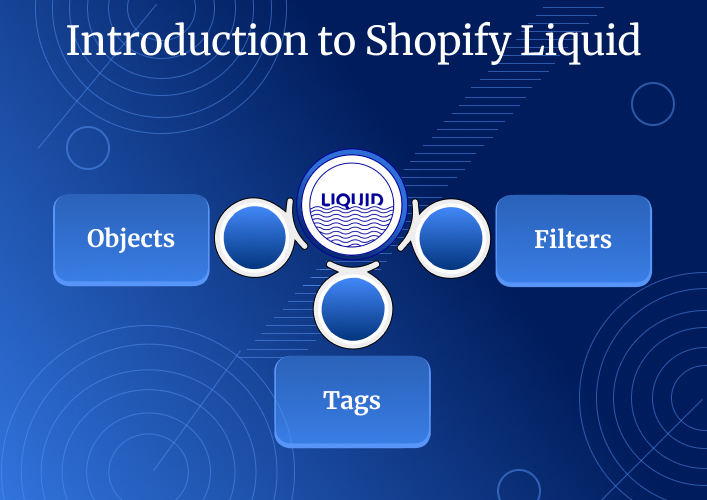Introduction to Shopify Liquid
When developing Shopify, its developers built an open-source project that became the platform’s template language. To facilitate the transfer of information between your shop and Shopify’s server, Shopify Liquid serves as an interface. In this sense, it is more accurately described as a template engine or syntax than a language, while it employs standard programming structures such as if/then statements, logic, and loops.
The extension of the Liquid files is .Liquid. Furthermore, ‘{{ }}’ represents the output and {% %} represents the logic. The liquid is divided into 3 sections:
Brief on Shopify Liquid Objects
Objects have the content that you can see on the page of a Shopify store. In Liquid, the objects are written in {{ }} and show output on the page. A dot(.) separates the object from the properties. For example, object{{product.title}}. Here, product: a term before “.” is the object, and title: a term after “.” is the property. Template and section files for your Shopify shop also include scripts and stylesheets generated by Shopify or third-party applications. Additionally, global objects may be accessed from any .Liquid file in your theme. Here is what you see when you use them:
- {{ articles }} – Your website’s articles’s index.
- The next example is {{ cart }} – Cart of your store.
- {{ blogs }} – All the site blogs’s index.
- Lastly, {{ collections }} – An index of your collections.
Brief on Shopify Liquid Tags
Tags help in building the logic and controlling the flow of the templates. When a template is generated, text in {% %} doesn’t display visible output. Thus, you can set the conditions, assign variables, and implement loops without showing on the page. They have the ability to alter the presentation of objects, execute if/then commands, and build loops. There are theme tags, control flow tags variable tags, and iteration tags.
Brief on Shopify Liquid Filters
Filters are sections of code that alter the results produced by an object. They can also alter the appearance of the website by altering its color scheme, typeface, and size. However, they are not limited to only altering the external look of an object; they may also conduct actions on it. They are used with {{ }} and variable assignment and are separated by the pipe character. Additionally, it assists theme designers in reducing their workload and saving time. For example, {{ blog.title | lowercase }}. Here, the blog title will be seen in lowercase.
Benefits of Shopify Liquid
Let’s assume you’re a web designer or developer. The main benefit is that, all of the data for a given Shopify shop is saved on the Shopify server from the moment it is created, making it easy to access using Liquid. The advantages extend beyond web developers to business owners who just want to update their stores:
- Liquid’s concise syntax and straightforward design make it approachable for both programmers and non-programmers.
- Liquid facilitates the development of dynamic content.
- Liquid allows you to design your own eCommerce store’s layouts and themes, allowing you full creative freedom over its appearance.
- When compared to other template engines, the performance of stores built using Liquid is superior.
- Shopify’s large user base is an invaluable resource for answering questions and getting help with any issues you may have while using Liquid.
Resources for Shopify Liquid
- Get a firm grasp on Liquid first; doing so will pave the way to creating more intricate custom themes. With this knowledge, new Shopify users will be able to fully use the platform to establish compelling online businesses.
- Your custom theme has to be tested to make sure it displays correctly in all browsers and on all devices. Early identification of issues helps reduce customer unhappiness.
- Shopify provides a plethora of resources for theme creators, so make use of them. You can find Shopify Liquid Templates, Liquid References, Liquid Learning Series, and Shopify Liquid Cheatsheet.
Conclusion
Customizing and developing Shopify themes relies heavily on Shopify Liquid, a powerful and flexible templating language. By incorporating logic and generating dynamic material directly into the theme files, developers and shop owners may construct highly customized and engaging online storefronts. The syntax of Liquid is friendly and simple to learn, making it suitable for programmers of all skill levels. By making use of Liquid, Shopify store owners may improve their customers’ shopping experiences, come up with original layouts, and boost their shops’ performance.
How does Liquid work in Shopify?
Liquid tags, filters, and objects are used to insert logic and display dynamic content in Shopify themes. Tags enclose control statements, filters modify variables, and objects provide access to data. Together, they create a dynamic rendering engine for Shopify themes.
Can non-developers use Shopify Liquid?
While Shopify Liquid is primarily designed for developers, non-developers and store owners can learn to use basic Liquid tags and filters to make simple modifications to their themes. However, more complex customizations might require some programming knowledge.
What are Liquid tags and filters?
Liquid tags are enclosed in curly braces and control the logic and flow of a template. They include control structures like loops and conditionals. Filters are used to modify the output of variables, such as formatting dates or capitalizing text.
What are some common use cases for Liquid?
Liquid is used to customize the layout, styling, and functionality of Shopify themes. Common use cases include creating custom product templates, building unique navigation menus, implementing dynamic collections, and designing engaging homepage sections.
Is Liquid the only way to customize Shopify themes?
While Liquid is the primary method for customizing Shopify themes, developers can also use HTML, CSS, JavaScript, and Shopify’s Theme Editor to make changes. However, Liquid is necessary for adding dynamic content and logic.
